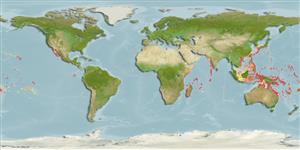Teleostei (teleosts) >
Ophidiiformes (Cusk eels) >
Carapidae (Pearlfishes) > Carapinae
Etymology: Onuxodon: Greek, onyx, -ychos = nail + Greek, odous = teeth (Ref. 45335).
More on author: Fowler.
Environment: milieu / climate zone / depth range / distribution range
Ecology
Marine; demersal; depth range 1 - 30 m (Ref. 58302). Subtropical
Indo-Pacific: South Africa to Hawaii.
Size / Weight / Age
Maturity: Lm ? range ? - ? cm
Max length : 10.0 cm TL male/unsexed; (Ref. 4104)
Dorsal soft rays (total): 44 - 47; Anal soft rays: 44 - 51. Eel-like, shallow to moderate body depth; adults small, less than 100 mm, trunk compressed; 1 to several large symphyseal fangs on premaxilla and dentary; anterior swim bladder modified into 'rockerbone'; predorsal bone present; pectoral fin rays supported by numerous small distal radials (Ref. 34024). Pectoral fins short; eyes small; lateralis papillae not visible on head or anterior lateral line (Ref. 34024).
A benthic species (Ref. 58302, 75154) found in coral reefs (Ref. 75154). Uncommon species (Ref. 34024). Commensal inquiline in the giant oyster Pycnodonta hyotis (Ref. 4104).
Life cycle and mating behavior
Maturity | Reproduction | Spawning | Eggs | Fecundity | Larvae
Nielsen, J.G., D.M. Cohen, D.F. Markle and C.R. Robins, 1999. Ophidiiform fishes of the world (Order Ophidiiformes). An annotated and illustrated catalogue of pearlfishes, cusk-eels, brotulas and other ophidiiform fishes known to date. FAO Fish. Synop. 125(18):178p. Rome: FAO. (Ref. 34024)
IUCN Red List Status (Ref. 130435: Version 2024-2)
Threat to humans
Harmless
Human uses
Fisheries: of no interest
Tools
Special reports
Download XML
Internet sources
Estimates based on models
Preferred temperature (Ref.
123201): 23.1 - 29.2, mean 28 °C (based on 2331 cells).
Phylogenetic diversity index (Ref.
82804): PD
50 = 0.6250 [Uniqueness, from 0.5 = low to 2.0 = high].
Bayesian length-weight: a=0.00102 (0.00046 - 0.00225), b=3.06 (2.88 - 3.24), in cm total length, based on all LWR estimates for this body shape (Ref.
93245).
Trophic level (Ref.
69278): 3.3 ±0.4 se; based on size and trophs of closest relatives
Fishing Vulnerability (Ref.
59153): Low vulnerability (10 of 100).
